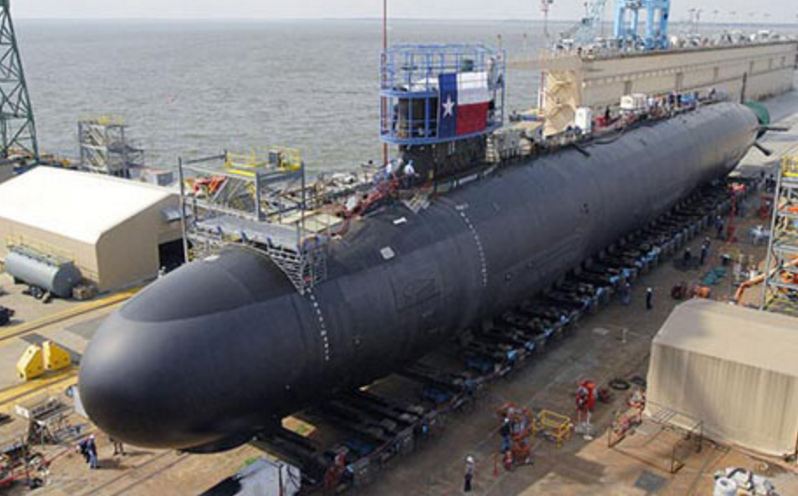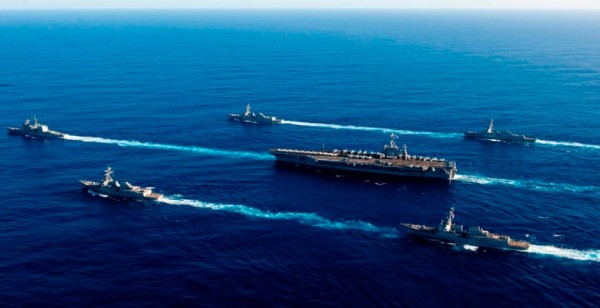Top US Navy Admirals say the Navy can Neutralize China and Russia's A2/AD Strategy
| Arthur Dominic Villasanta | | Sep 05, 2016 09:49 AM EDT |
(Photo : US Navy) Carrier strike group of the USS John C. Stennis.
Two of the U.S. Navy's senior admirals agree the Navy has what it takes to defeat and operate within zones covered by China and Russia's land-based anti access/area denial (A2/AD) strategy.
Chief of Naval Operations Admiral John Richardson pointed out China and Russia can't prevent Navy aircraft carriers from operating where they want to and when they want to.
Like Us on Facebook
Asked if the Navy's Nimitz-class supercarriers and their carrier strike wings can fight inside Chinese and Russian A2/AD zones, Adm. Richardson unequivocally answered "Yes" but refused to give details.
Referring specifically to China, what's clear, he said, is China's alleged carrier-killing capabilities are only speculation.
"What you see often is a display of, 'Here's this launcher. Here's a circle with a radius of 700 miles, and it's solid-color black inside' ... And that's just not the reality of the situation," he noted.
"You've got this highly maneuverable force that has a suite of capabilities that the force can bring to bear to inject uncertainty."
China's heavily hyped but unproven "carrier killer," the DF-21D anti-ship ballistic missile (ASBM) only fired from land-based mobile launchers, has a maximum range over 1,450 kilometers but suffers from an immature kill chain due to a lack of long-range aerial drones (still being developed) and China's incomplete BeiDou navigation satellite system.
China a few months ago began production of its Xianglong (or Soaring Dragon) aerial drone it will use to designate enemy warship targets for ASBMs, jam enemy transmissions and attack warships. BeiDou will only have its full complement of 35 GPS satellites by 2020. China orbited its 23rd BeiDou satellite this August.
"I think there is this long-range precision-strike capability, certainly," said Adm. Richardson. He noted "A2/AD is sort of an aspiration. In actual execution, it's much more difficult."
The range of China's intelligence, surveillance and reconnaissance capabilities (ISR) have been widened with the militarization of its man-made islands or islands in the South China Sea illegally seized from other nations.
"The combination of ubiquitous ISR, long-range precision-strike weapons takes that to another level and demands a response," said Adm. Richardson, adding that China's extension into the Pacific created a "suite of capabilities" that were of "pressing concern."
Adm. Richardon said a long-range aerial drone must transmit target data back to an ASBM or another precision-guided weapon system that can reach out at a fairly long range.
"You're talking about hundreds of miles now, so that raises a challenge," he pointed out. "Our response would be to inject a lot of friction into that system at every step of the way (and) look to make that much more difficult."
On the other hand, Vice Admiral Mike Shoemaker, Commander, Naval Air Forces, said he's convinced of the Navy's ability to maneuver in a hostile environment such as that in an A2/AD zone. He also said the Navy can "create a battle space to do what we need to do, maneuver again and operate -- not with impunity -- but certainly with awareness of the risk that's out there."
He noted China's land-based A2/AD strategy that relies on ASBMs fired from the Chinese mainland means the Chinese defenses have a lot of sea to attack.
"That's a very long kill chain, "noted Adm. Shoemaker. "We have lots of things we do to disrupt that from all angles."
That kill chain will be disrupted by the speed and maneuverability of the Navy's Nimitz-class nuclear supercarriers that can travel at speeds of up to 30 knots (56 km/h) and maneuver quite well for a warship weighing over 100,000 tons.
He explained the problem with long range missiles is that while they're excellent at destroying land targets, they're not quite as effective against targets such as US Navy warships maneuvering at speed.
Navy warships will use a combination of speed, maneuverability and defensive systems to fight while being attacked by enemy anti-ship cruise missiles and ASBMs, he said.
Meanwhile, the carrier air wing will rely on the F-35C; the forthcoming MQ-25A Stingray aerial tanker drone and its Boeing F/A-18E/F Super Hornets and EA-18G Growler electronic attack aircraft to defeat modern enemy air defenses such as Russia's S-300 and S-400 surface-to-air missile systems.
TagsU.S. Navy, Admiral John Richardson, Vice Admiral Mike Shoemaker, china, Russia, DF-21D, Xianglong
©2015 Chinatopix All rights reserved. Do not reproduce without permission
 World Awaits China Action on Scarborough Shoal Reclamation
World Awaits China Action on Scarborough Shoal Reclamation China is an Outlaw State that Doesn’t Respect International Law, says US Expert
China is an Outlaw State that Doesn’t Respect International Law, says US Expert USS Illinois, Newest Virginia-class Attack Submarine, Delivered to US Navy
USS Illinois, Newest Virginia-class Attack Submarine, Delivered to US Navy US Navy to Deploy New Virginia-class Attack Submarines to Asia
US Navy to Deploy New Virginia-class Attack Submarines to Asia US Navy can Defeat China’s A2/AD Strategy
US Navy can Defeat China’s A2/AD Strategy
EDITOR'S PICKS
-

Did the Trump administration just announce plans for a trade war with ‘hostile’ China and Russia?
-

US Senate passes Taiwan travel bill slammed by China
-

As Yan Sihong’s family grieves, here are other Chinese students who went missing abroad. Some have never been found
-

Beijing blasts Western critics who ‘smear China’ with the term sharp power
-

China Envoy Seeks to Defuse Tensions With U.S. as a Trade War Brews
-

Singapore's Deputy PM Provides Bitcoin Vote of Confidence Amid China's Blanket Bans
-

China warns investors over risks in overseas virtual currency trading
-

Chinese government most trustworthy: survey
-

Kashima Antlers On Course For Back-To-Back Titles
MOST POPULAR
LATEST NEWS
Zhou Yongkang: China's Former Security Chief Sentenced to Life in Prison

China's former Chief of the Ministry of Public Security, Zhou Yongkang, has been given a life sentence after he was found guilty of abusing his office, bribery and deliberately ... Full Article
TRENDING STORY

China Pork Prices Expected to Stabilize As The Supplies Recover

Elephone P9000 Smartphone is now on Sale on Amazon India

There's a Big Chance Cliffhangers Won't Still Be Resolved When Grey's Anatomy Season 13 Returns

Supreme Court Ruled on Samsung vs Apple Dispute for Patent Infringement

Microsoft Surface Pro 5 Rumors and Release Date: What is the Latest?










